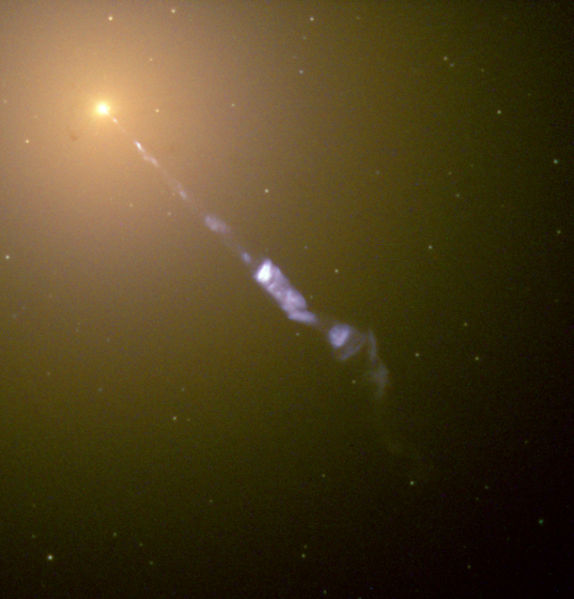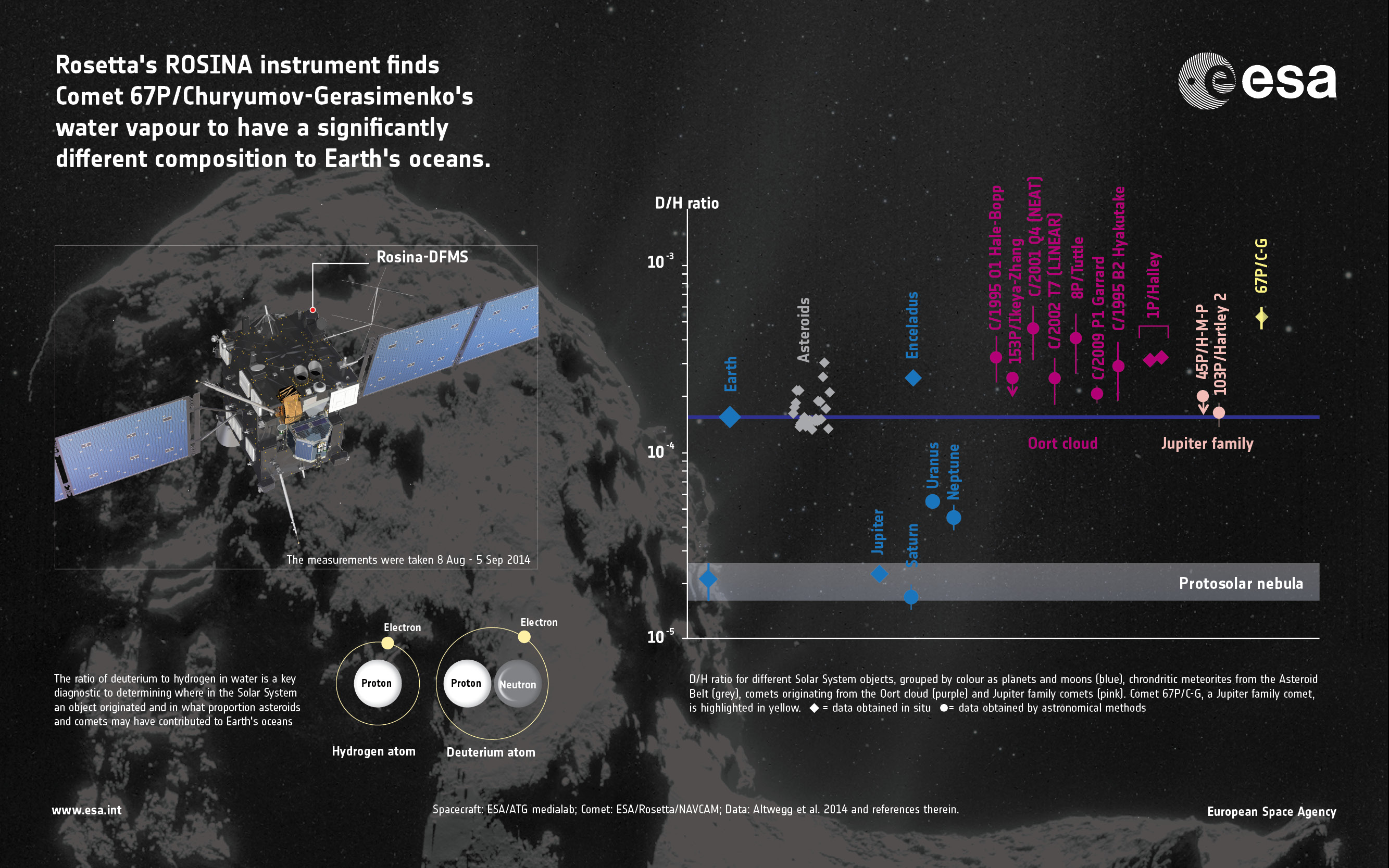Quasars Are Aligned
Quasars are black holes at the edge of our observable universe that are very actively consuming material. They are the most luminous objects we know of, outshining entire galaxies and even supernovae. A well-known feature of black holes is the "event horizon," the point at which there is no escaping the gravity of the black hole. Until you reach that point, there is hope of escaping and the closer you get, the more turbulent things are. A quasar's extreme brightness comes from all of the particles escaping that turbulence getting spewed into a concentrated beam, which looks a little something like this:
It was discovered that the axes of many quasars are actually aligned, despite being separated by billions of light-years. That separation should make it impossible for them to affect each other, suggesting that something early in their formation led them to be aligned. An even more remarkable discovery is that they are not just aligned with each other, but aligned with the large-scale structure in their local region. At very large spatial scales, the Universe does appear to have structure. Stars and galaxies are not uniformly distributed, but clump along filaments. The quasar axes seem to be aligned with the filaments. This is not as yet predicted by our numerical models, so there must be something at work beyond our current understanding.
It was discovered that the axes of many quasars are actually aligned, despite being separated by billions of light-years. That separation should make it impossible for them to affect each other, suggesting that something early in their formation led them to be aligned. An even more remarkable discovery is that they are not just aligned with each other, but aligned with the large-scale structure in their local region. At very large spatial scales, the Universe does appear to have structure. Stars and galaxies are not uniformly distributed, but clump along filaments. The quasar axes seem to be aligned with the filaments. This is not as yet predicted by our numerical models, so there must be something at work beyond our current understanding.
Fine Structure Constant is indeed Constant
There has been debate amongst physicists as to whether the fine-structure constant is indeed constant. Just like gravity has Newton's constant that determines how strongly massive objects attract, electromagnetism has the fine-structure constant to determine how strong charged particles attract or repel. Like with methane on Mars, there seemed to be an observation that showed the fine structure constant actually changed over the course of the Universe's lifetime, but there wasn't enough data to generate certainty, then others proposed alternate explanations, etc.
Well, the most recent set of data seems to indicate the fine-structure constant has not changed over a significant portion of the Universe's life. Apparently, by looking at the light from a quasar after it has slipped past galaxies at varying distances, we can deduce the fine-structure constant at the time the light passed by the galaxies. In the case of the most recent study, the galaxies were 8, 9 and 10 billion light-years away, indicating the fine-structure constant hasn't changed in 10 billion years. The authors of the paper, in typical scientific fashion, noted that this doesn't close the door on the possibility of the fine-structure constant changing, only imposes much stricter limits on how much it might have changed. It does rule out much of the larger shifts previously proposed.
Well, the most recent set of data seems to indicate the fine-structure constant has not changed over a significant portion of the Universe's life. Apparently, by looking at the light from a quasar after it has slipped past galaxies at varying distances, we can deduce the fine-structure constant at the time the light passed by the galaxies. In the case of the most recent study, the galaxies were 8, 9 and 10 billion light-years away, indicating the fine-structure constant hasn't changed in 10 billion years. The authors of the paper, in typical scientific fashion, noted that this doesn't close the door on the possibility of the fine-structure constant changing, only imposes much stricter limits on how much it might have changed. It does rule out much of the larger shifts previously proposed.
Black Holes Can Be Ejected During Galaxy Merger
While generations of humans have stared at what seem like unchanging heavens, the fact is the Universe is a very dynamic place. One of the more dramatic examples of this dynamism is when galaxies merge; and one of the more dramatic things that can happen when galaxies merge is one of the central black holes can be ejected from the merged galaxy. Check out this here video.
This is like intergalactic bumper cars and it's very impressive that a simulation can match observation so closely. Once again, in good scientific fashion, the authors of the study are quick to note there is an alternate explanation involving an ultra-large star going supernova. Generally, supernova fade over a few years, so the persistence of this object seems to favor the black-hole-bumper-car theory. Even for the largest of stars going supernova, the explosion should fade over the next few years, so we should find relatively soon if that is a possibility.
This is like intergalactic bumper cars and it's very impressive that a simulation can match observation so closely. Once again, in good scientific fashion, the authors of the study are quick to note there is an alternate explanation involving an ultra-large star going supernova. Generally, supernova fade over a few years, so the persistence of this object seems to favor the black-hole-bumper-car theory. Even for the largest of stars going supernova, the explosion should fade over the next few years, so we should find relatively soon if that is a possibility.
Binary Star Formation Imaged
ALMA took some images of a binary star system and this is what it saw.
Well, what's over there on the left is what was seen. On the right is a simulation. It may not look like much, but it is our most detailed view of binary star formation. Our understanding of single star formation such as our sun is pretty advanced. However, our understanding of binary star formation is not quite as mature. From the many images captured of this system forming, it appears that gas is indeed falling in to the two stars, leading to the relatively empty inner ring. This is no different from single star formation. What's different is the shape of the circumbinary disk. With two stars pushing and pulling on the gas within that disk, it is far from radially symmetric, like the planet-formation seen in this other image from ALMA (which has nothing to do with star formation, but is pretty).
Well, what's over there on the left is what was seen. On the right is a simulation. It may not look like much, but it is our most detailed view of binary star formation. Our understanding of single star formation such as our sun is pretty advanced. However, our understanding of binary star formation is not quite as mature. From the many images captured of this system forming, it appears that gas is indeed falling in to the two stars, leading to the relatively empty inner ring. This is no different from single star formation. What's different is the shape of the circumbinary disk. With two stars pushing and pulling on the gas within that disk, it is far from radially symmetric, like the planet-formation seen in this other image from ALMA (which has nothing to do with star formation, but is pretty).






